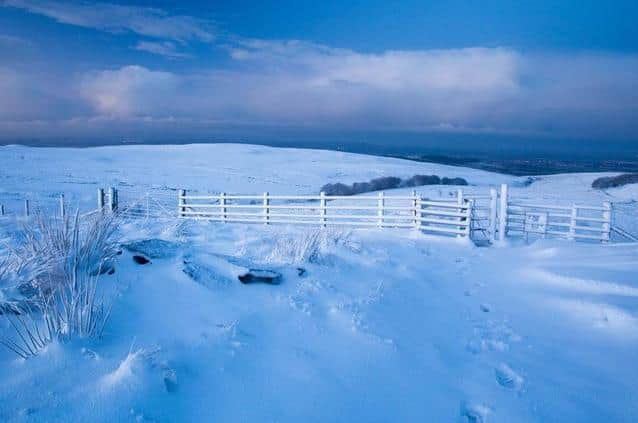This is what the weather will be like in Lancashire on Christmas Day
and live on Freeview channel 276
Not since 2010, when the whole of Lancashire looked like a winter wonderland, has the county been blanketed in snow on Christmas morning, though a year earlier there was snowfall in some areas.
So is Jack Frost heading to Lancashire this Christmas and bringing with him a White Christmas - here's what the Met Office forecasts ...
Advertisement
Hide AdAdvertisement
Hide AdFrom December 16 to December 30: It will remain generally unsettled at first, with wet and windy conditions likely moving further north with drier and brighter spells developing in the south and southeast at times. Temperatures are likely to be milder than earlier in the month, with temperatures near to above normal, although some colder spells remain possible. It is likely to become more settled around Christmas and towards the New Year with an increased chance of overnight frost and fog during clearer spells.


There is the possibility of snow from December 7 to December 16 but a White Christmas doesn't look on the cards this year.
Whether you dread the windy weather or look forward to the crisp mornings, here are eight interesting facts about winter, courtesy of the Met Office.
1. Winter is coming
There are two different dates when winter could be said to begin, depending on whether we are referring to the Meteorological or Astronomical winter.
Advertisement
Hide AdAdvertisement
Hide AdAstronomical winter is defined by the Earth’s orbit around the Sun and begins on the winter solstice, which falls on 21 or 22 December.
However, when recording and comparing climate data, it is important to have set dates that can be compared and so for this reason a fixed date of 1 December is used to mark the start of the meteorological winter.
2. Earth is closest to the Sun in winter
You might be surprised to know that in the northern hemisphere the Earth is closest to the Sun during winter.
Around 3 January, the Earth reaches perihelion (peri meaning 'near' and helion meaning 'sun') and the Earth is 3.1 million miles closer to the Sun than at aphelion (around 5 July when the Earth is furthest from the Sun).
Advertisement
Hide AdAdvertisement
Hide AdEarth's distance from the Sun is not what causes the seasons but it does affect the length of them. Around perihelion, the Earth is moving around 1 kilometre per second faster than at aphelion which results in winter being 5 days shorter than summer.
3. The coldest temperature recorded in winter
The coldest temperature ever recorded during a UK winter was -27.2 °C, which has been recorded 3 times. It was twice recorded in the village of Braemar, on 11 February 1895 and again on 10 January 1982, and once in Altnaharra on 30 December 1995. Both sites are in the Scottish Highlands.
4. The winter of 1963
The winter of 1963 is one of the coldest on record and the coldest since 1740. Temperatures consistently reached lower than - 20 °C with blizzards, snowdrifts and even the sea freezing around the coast.
The severe cold began just before Christmas in 1962 as a high pressure system sat to the northeast of the UK for much of the winter, dragging cold polar winds over the UK.
Advertisement
Hide AdAdvertisement
Hide AdOn 29 and 30 December, a blizzard struck the UK with snowdrifts up to 6 metres deep. Snow continued to fall frequently and until early March 1963, much of the UK remained covered in snow.
5. The roots of winter
The word winter comes from the Germanic wintar which in turn is derived from the root wed meaning 'wet' or water', and so signifies a wet season.
In Anglo-Saxon cultures, years were counted by the winters, so a person could be said to be '2 winters old.' The first day of winter was also of symbolic importance named Vetrardag and falling comparatively early in the year between 10 and 16 October.
6. Wet snow v dry snow
Ever wondered why sometimes snow sticks together and sometimes it's powdery and loose? The reason for this lies in the snowflake's journey as it falls through the atmosphere.
Advertisement
Hide AdAdvertisement
Hide AdSnowflakes that fall through a dry, cool atmosphere will be small and powdery and won't stick together. We call this dry snow - it's ideal for skiing, but not for building a snowman.
The snowflakes that form wet snow will have fallen through temperatures slightly warmer than 0 °C. As they fall, the snowflakes melt slightly around the edges and stick together to form large, heavy flakes. These stick together easily and are the best for a snowball fight and making snowmen.
7. Reindeer vision
Some reindeer living above the Arctic Circle live in complete darkness for several weeks of the year.
To adapt to this, a small area of tissue behind the retina called the tapetum lucidum changes colour from a gold colour in summer months to blue in winter. This allows the reindeer's eyes to detect ultraviolet light and to see in the dark.
8. How much water is there in snow?
The exact amount of water contained in snow can vary quite significantly depending on how the snow formed, but as a general average, every 12 cm of snow would provide 1 cm of water.
Comment Guidelines
National World encourages reader discussion on our stories. User feedback, insights and back-and-forth exchanges add a rich layer of context to reporting. Please review our Community Guidelines before commenting.